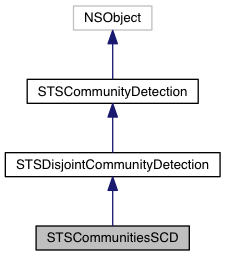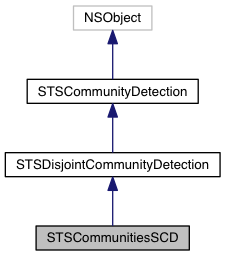CommunitiesSCD class. More...


Instance Methods | |
| (id) | - initWithSession: |
| Creates a new instance of CommunitiesSCD. More... | |
| (void) | - setLookAhead: |
| Sets the size of the lookahead iterations to look (5 by default). More... | |
| (void) | - run |
| Executes the algorithm. | |
| (void) | - addEdgeType: |
| Allows connectivity through edges of the given type. More... | |
| (void) | - addAllEdgeTypes |
| Allows connectivity through all edge types of the graph. More... | |
| (STSDisjointCommunities *) | - getCommunities |
| Returns the results generated by the execution of the algorithm. More... | |
| (void) | - setMaterializedAttribute: |
| Creates a new common attribute type for all node types in the graph in order to store, persistently, the results related to the disjoint communities found while executing this algorithm. More... | |
| (void) | - addNodeType: |
| Allows connectivity through nodes of the given type. More... | |
| (void) | - addAllNodeTypes |
| Allows connectivity through all node types of the graph. | |
| (void) | - excludeNodes: |
| Set which nodes can't be used. More... | |
| (void) | - excludeEdges: |
| Set which edges can't be used. More... | |
| (void) | - includeNodes: |
| Set additional nodes that can be used. More... | |
| (void) | - includeEdges: |
| Set additional edges that can be used. More... | |
| (void) | - close |
| Closes the CommunityDetection instance. More... | |
| (BOOL) | - isClosed |
| Check if the CommunityDetection instance is closed. | |
Detailed Description
CommunitiesSCD class.
Implementation of the community detection algorithm "Scalable Community Detection" based on the paper "High quality, scalable and parallel community detection for large real graphs" by Arnau Prat-Perez, David Dominguez-Sal, Josep-Lluis Larriba-Pey - WWW 2014.
The purpose of this algorithm is to find disjoint communities in an undirected graph or in a directed graph which will be considered as an undirected one.
It is possible to set some restrictions after constructing a new instance of this class and before running it in order to limit the results.
After the execution, we can retrieve the results stored in an instance of the DisjointCommunities class using the getCommunities method.
Check out the 'Algorithms' section in the SPARKSEE User Manual for more details on this.
Method Documentation
| - (void) addAllEdgeTypes |
Allows connectivity through all edge types of the graph.
The edges can be used in Any direction.
| - (void) addEdgeType: | (int) | type |
Allows connectivity through edges of the given type.
The edges can be used in Any direction.
- Parameters
-
type [in] Edge type.
| - (void) addNodeType: | (int) | type |
Allows connectivity through nodes of the given type.
- Parameters
-
type null
| - (void) close |
Closes the CommunityDetection instance.
It must be called to ensure the integrity of all data.
| - (void) excludeEdges: | (STSObjects *) | edges |
Set which edges can't be used.
This will replace any previously specified set of excluded edges. Should only be used to exclude the usage of specific edges from allowed edge types because it's less efficient than not allowing an edge type.
- Parameters
-
edges [in] A set of edge identifiers that must be kept intact until the destruction of the class.
| - (void) excludeNodes: | (STSObjects *) | nodes |
Set which nodes can't be used.
This will replace any previously specified set of excluded nodes. Should only be used to exclude the usage of specific nodes from allowed node types because it's less efficient than not allowing a node type.
- Parameters
-
nodes [in] A set of node identifiers that must be kept intact until the destruction of the class.
| - (STSDisjointCommunities*) getCommunities |
Returns the results generated by the execution of the algorithm.
These results contain information related to the disjoint communities found as the number of different components, the set of nodes contained in each component or many other data.
- Returns
- Returns an instance of the class DisjointCommunities which contain information related to the disjoint communities found.
| - (void) includeEdges: | (STSObjects *) | edges |
Set additional edges that can be used.
This will replace any previously specified set of include edges. Using this optional method adds valid edges to the edges of any edge type explicitly set as a valid type. Should only be used to include specific small sets of edges because it's less efficient than just using an edge type. For any edge to be used, both nodes must be also valid.
- Parameters
-
edges [in] A set of edge identifiers that must be kept intact until the destruction of the class.
| - (void) includeNodes: | (STSObjects *) | nodes |
Set additional nodes that can be used.
This will replace any previously specified set of include nodes. Using this optional method adds valid nodes to the nodes of any node type explicitly set as a valid type. Should only be used to include specific small sets of nodes because it's less efficient than just using a node type.
- Parameters
-
nodes [in] A set of node identifiers that must be kept intact until the destruction of the class.
| - (id) initWithSession: | (STSSession *) | session |
Creates a new instance of CommunitiesSCD.
After creating this instance is required to indicate the set of edge types and the set of node types which will be navigated through while traversing the graph in order to find the communities.
- Parameters
-
session [in] Session to get the graph from and calculate the communities
| - (void) setLookAhead: | (int) | lookahead |
Sets the size of the lookahead iterations to look (5 by default).
- Parameters
-
lookahead [in] Number of iterations. It must be positive or zero.
| - (void) setMaterializedAttribute: | (NSString *) | attributeName |
Creates a new common attribute type for all node types in the graph in order to store, persistently, the results related to the disjoint communities found while executing this algorithm.
Whenever the user wants to retrieve the results, even when the graph has been closed and opened again, it is only necessary to create a new instance of the class DisjointCommunities indicating the graph and the name of the common attribute type which stores the results. This instance will have all the information related to the disjoint communities found in the moment of the execution of the algorithm that stored this data.
It is possible to run the algorithm without specifying this parameter in order to avoid materializing the results of the execution.
- Parameters
-
attributeName [in] The name of the common attribute type for all node types in the graph which will store persistently the results generated by the execution of the algorithm.
The documentation for this class was generated from the following file:
- Sparksee.h
